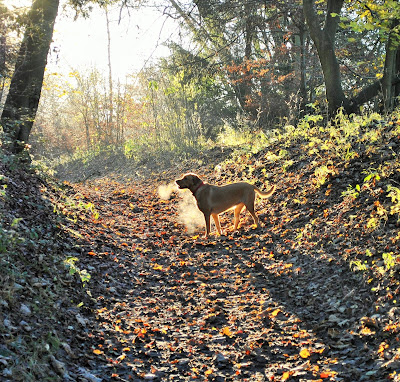It's been a strange fungi season so far. We've made a few fantastic discoveries, but the masses of fungi that we usually see in the Chilterns just haven't been there. It's been a dry, mild autumn so far and the fungi just don't seem to like it. They're all out there though, biding their time, just waiting for the perfect conditions. Perhaps the recent soggy, foggy weather was what they were all waiting for ...
 |
| Very majestic magpie inkcap |
My hopes were raised when I found the most enormous magpie inkcap in the car park at Pulpit Hill. There were at least 8 in a small patch of ground that had been cleared earlier in the year. Just shows how much wildlife can benefit from the hard work that goes into keeping scrub and bushes clear.
They're one of my favourite fungi as they are so majestic and distinctive. Blink and you'll miss them though as they drip away to nothing within a couple of days.
The fog was thick in places and there were so many leaves falling from the trees that it sounded like a crackling fire in the treetops. It was all very Halloweeny!
Large troops of clouded funnels had pushed their way up through the leaf litter. They're common fungi, but had been noticeable by their absence this autumn. They were obviously waiting for some damp, foggy weather to emerge as I found patches of them throughout the woods.
 |
| A large troop of clouded funnels marching off through the woods |
 |
| Clouded funnel |
Elsewhere there were clumps of little white bonnets on fallen branches, pretty pink rosy bonnets in the leaf litter and russet toughshanks with their curled up edges. All common enough finds, but again they've been missing in any great number this year, so it was good to finally see so many around.
 |
| Delicate little bonnets |
 |
| Rosy bonnets |
 |
| Russet toughshanks |
The hill fort at the top of the hill felt extra spooky and atmospheric.
Black bulgar was growing on a fallen tree trunk ...
... hairy curtain crust, with a liberal sprinkling of leaves, covered a tree stump ...
... and the centre of the hill fort was covered in small toadstools with a dusting of yellow sprinkles on the cap and stipe. I'm not sure what they were, but they were quite unusual.
Some beautiful porcelain fungus was growing up high on a tree trunk ...
... and a couple of toadstools were growing out of a tree trunk. They had bright yellow gills and a yellow cap that was covered in red speckles. They may be dappled webcaps (but I'm not totally sure).
Feels like the fungi have finally burst into life. Maybe were going to have a late fungi season this year!
































